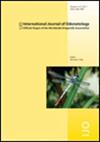豆娘模型翼的气动干扰主要取决于桨面间距和翼展弦比
IF 1
4区 农林科学
Q3 ENTOMOLOGY
引用次数: 4
摘要
昆虫气动力控制的流体动力学取决于振动翅膀如何与周围空气相互作用。所产生的流动结构是由机翼的瞬时运动引起的流动所形成的,但也由先前的机翼冲程产生的力和其他翅膀在近距离拍打的运动所产生的流动成分所形成的。在四翼昆虫中,如少女和蜻蜓,后翅上的水流受到前翅下冲的影响。在这些动物中,前翼和后翼冲程周期之间的相移通过前缘涡破坏、局部流动条件的变化和尾迹捕获效应来调节后翼的气动性能。本文综述了翼-尾迹干涉对力控制的意义,表明在豆豆蝇模型翼中,相位相关力调制的强度严重依赖于前、后翼冲程平面的垂直间距和两翼的展弦比。我们得出结论,少女和蜻蜓在前翅和后翅拍动距离近且长度相近的情况下,身体姿态控制的转向能力达到最大。后者的发现对昆虫翅膀的进化和多样化具有重要意义,因为它可以解释为什么在翅目中前翅和后翅差异不大。本文章由计算机程序翻译,如有差异,请以英文原文为准。
Aerodynamic interference depends on stroke plane spacing and wing aspect ratio in damselfly model wings
The fluid dynamics of aerodynamic force control in insects depends on how oscillating wings interact with the surrounding air. The resulting flow structures are shaped by the flow induced by the wing’s instantaneous motion but also on flow components resulting from force production in previous wing strokes and the motion of other wings flapping in close proximity. In four-winged insects such as damsel- and dragonflies, the flow over the hindwings is affected by the forewing downwash. In these animals, a phase-shift between the stroke cycles of forewing and hindwing modulates aerodynamic performance of the hindwing via leading edge vortex destruction, changes in local flow condition and the wake capture effect. This review is engaged in the significance of wing-wake interference for force control, showing that in damselfly model wings the strength of phase-dependent force modulation critically depends on the vertical spacing between forewing and hindwing stroke planes and the aspect ratio of both wings. We conclude that damsel- and dragonflies reach maximum steering capacity for body posture control when forewings and hindwings flap in close proximity and have similar length. The latter findings are of significance for the evolution and diversification of insect wings because they might explain why forewings and hindwings are little different in the order Odonatoptera.
求助全文
通过发布文献求助,成功后即可免费获取论文全文。
去求助
来源期刊

International Journal of Odonatology
ENTOMOLOGY-
CiteScore
2.30
自引率
0.00%
发文量
15
审稿时长
>12 weeks
期刊介绍:
International Journal of Odonatology (IJO) is aimed at providing a publication outlet for the growing number of students of Odonata. It will address subjects such as the ecology, ethology, physiology, genetics, taxonomy, phylogeny and geographic distribution of species. Reviews will be by invitation, but authors who plan to write a review on a subject of interest to the journal are encouraged to contact the editor.
 求助内容:
求助内容: 应助结果提醒方式:
应助结果提醒方式:


